-
1 of 253523 objects
Nautilus cup c.1600
Nautilus shell with parcel-gilt silver mounts | 52.0 x 24.0 x 17.0 cm; 3946 g (whole object) | RCIN 50603
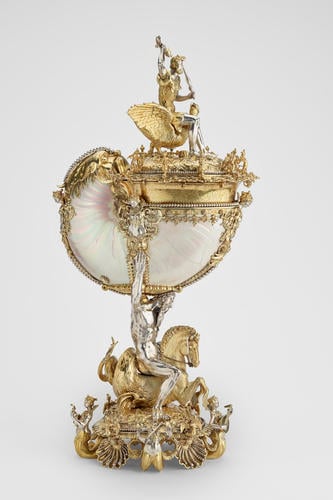
Nikolaus Schmidt (c. 1550/55-1609)
Nautilus cup c.1600
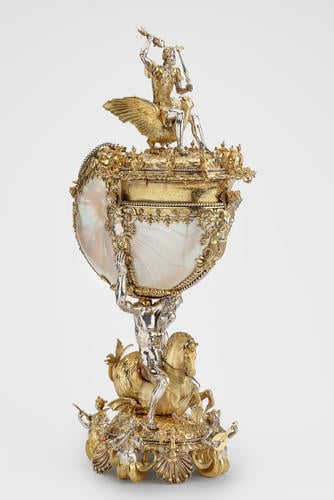
Nikolaus Schmidt (c. 1550/55-1609)
Nautilus cup c.1600
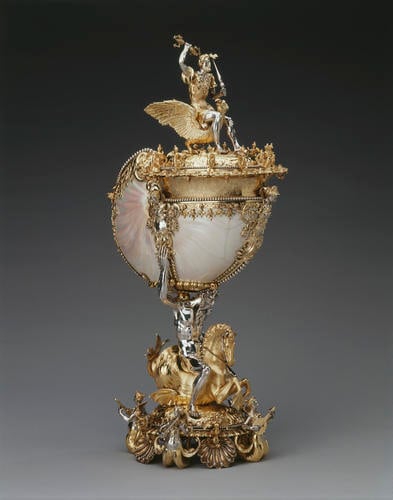
Nikolaus Schmidt (c. 1550/55-1609)
Nautilus cup c.1600
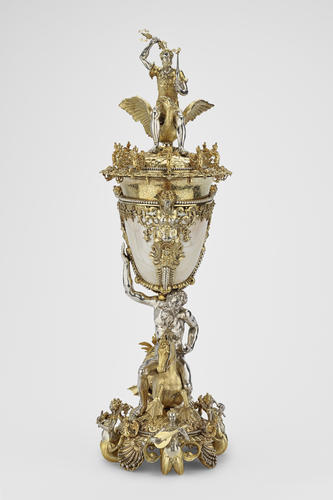
Nikolaus Schmidt (c. 1550/55-1609)
Nautilus cup c.1600
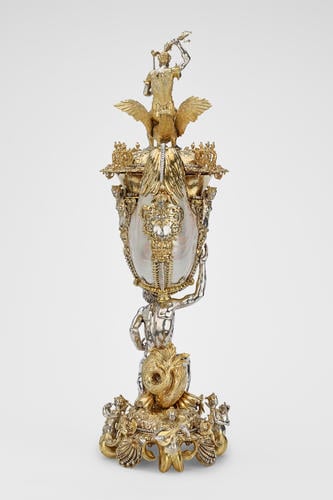
Nikolaus Schmidt (c. 1550/55-1609)
Nautilus cup c.1600
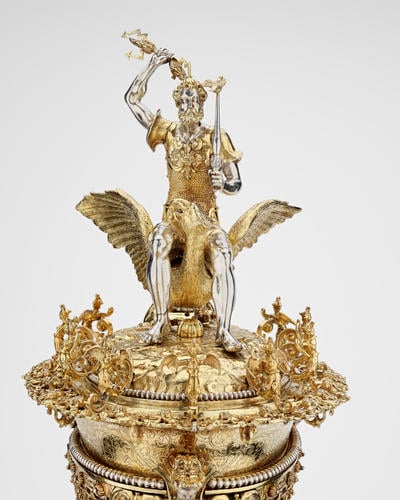
Nikolaus Schmidt (c. 1550/55-1609)
Nautilus cup c.1600

Nikolaus Schmidt (c. 1550/55-1609)
Nautilus cup c.1600
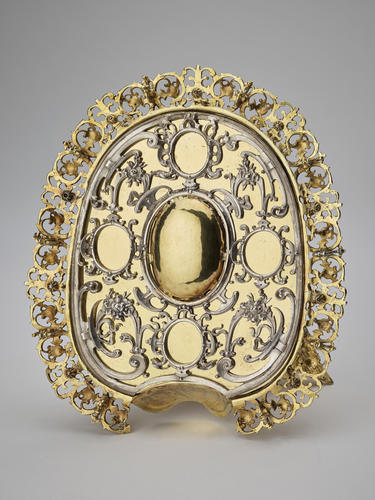
Nikolaus Schmidt (c. 1550/55-1609)
Nautilus cup c.1600
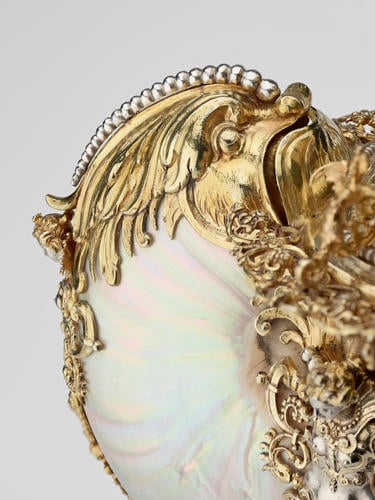
Nikolaus Schmidt (c. 1550/55-1609)
Nautilus cup c.1600
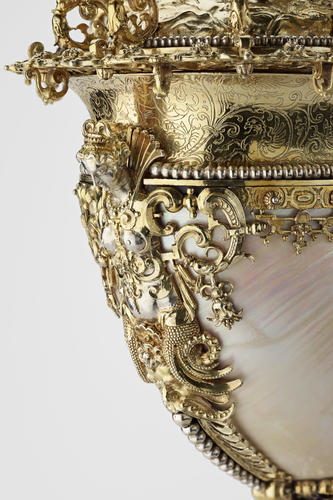
Nikolaus Schmidt (c. 1550/55-1609)
Nautilus cup c.1600
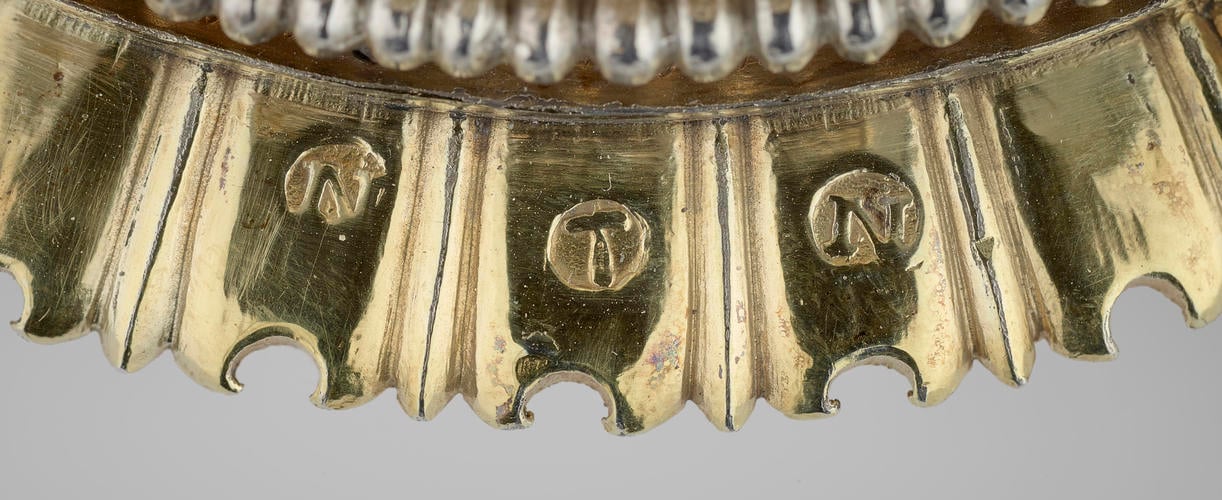
Nikolaus Schmidt (c. 1550/55-1609)
Nautilus cup c.1600
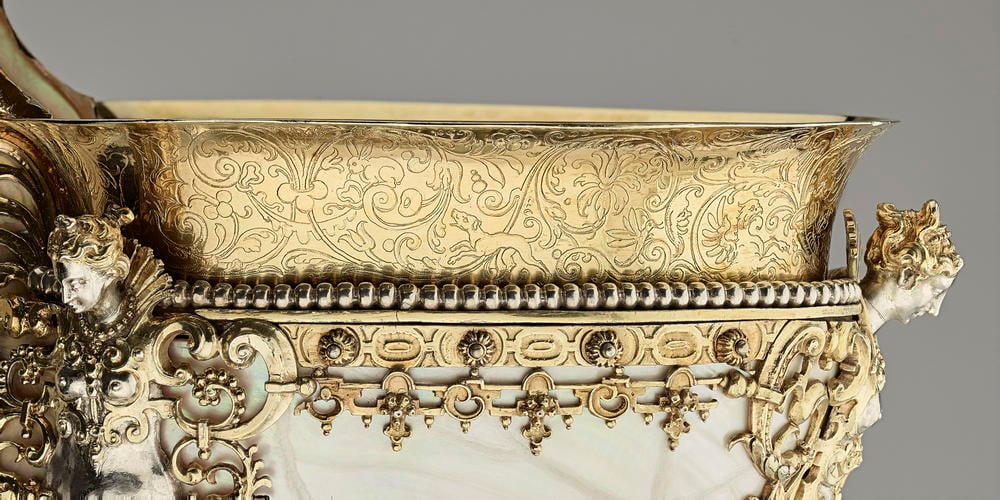
Nikolaus Schmidt (c. 1550/55-1609)
Nautilus cup c.1600
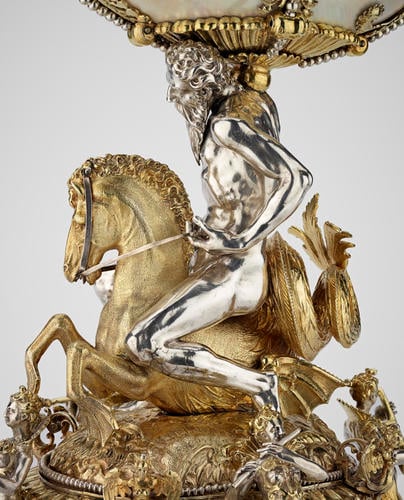
Nikolaus Schmidt (c. 1550/55-1609)
Nautilus cup c.1600
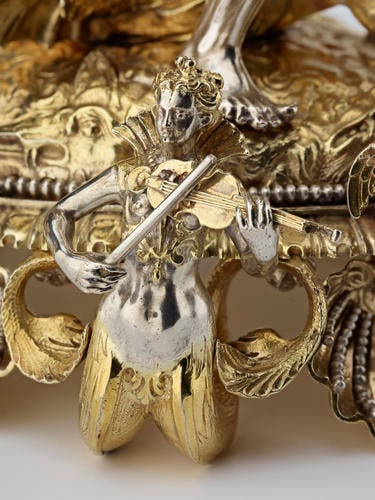
Nikolaus Schmidt (c. 1550/55-1609)
Nautilus cup c.1600
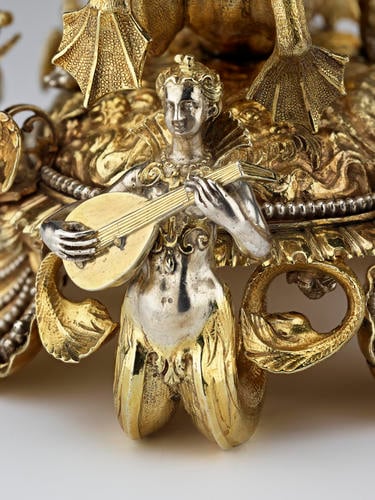
Nikolaus Schmidt (c. 1550/55-1609)
Nautilus cup c.1600
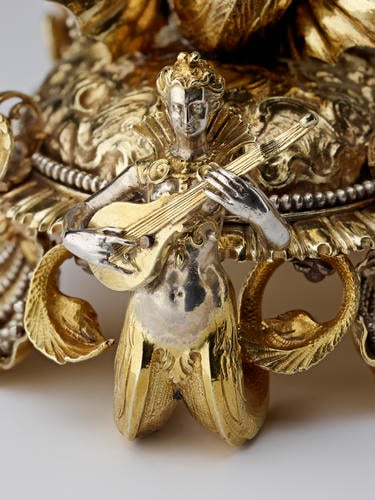
Nikolaus Schmidt (c. 1550/55-1609)
Nautilus cup c.1600
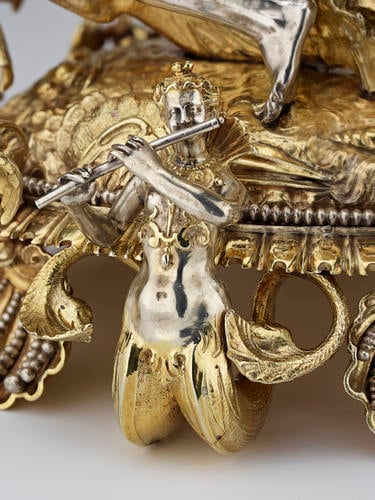
Nikolaus Schmidt (c. 1550/55-1609)
Nautilus cup c.1600

















-
The large nautilus shell is supported on the shoulder of a figure of Neptune, with one arm upraised, riding a hippocamp with a curled tail, on a domed base chased with sea monsters and shells. The base has a silver beaded rim and four feet cast as double-tailed mermaids playing instruments – a guitar, a viol, a lute and a flute – with scallop shells and harpy terms between. The base of the shell sits in a gadrooned calyx and is held by beaded straps, each surmounted by an espagnolette-like female term. The cup has an upper border of ovolo mouldings and flower heads in relief, beneath a lip engraved with strapwork scrolls, flower heads and small running hounds. The oval cover is surmounted by a figure of Jupiter hurling thunderbolts from his upraised right hand, and holding a sceptre surmounted by a dove in his left, seated on an eagle, its wings outspread and head twisted to one side, on a domed mound chased with clouds and putti heads (representing winds), with a beaded rim and border of cast scrolls and harpy terms, their wings outspread, and a pierced lip of C-scrolls and rosettes. The inside of the lid is overlaid with a cagework plaque cast with scrolls and oval reserves. The shell is carved at the cap as a helmet, and is mounted with a silver-gilt sea monster, with a beaded silver ridge along its spine.
This spectacular object is the work of Nikolaus Schmidt, who was born in Griefswald and trained with Wenzel Jamnitzer (1508–85) and Elias Lencker (1562–91) in Nuremberg. It constitutes one of the largest of all surviving nautilus cups, largely due to the incorporation of an exceptionally large shell. Schmidt worked in a similarly inventive style to his masters, creating items for the Kunstkammer. He became a master in 1582, although his original submission to the guild was rejected, and it was only at Jamnitzer’s intervention that he was given his freedom. He appears to have continued to collaborate with Jamnitzer after he received his own mark: the jewellery casket made for Princess Sophie, in the Grünes Gewölbe, Dresden (iv.115), is thought to be the result of a collaboration between Jamnitzer and Schmidt, the latter completing the work after Jamnitzer’s death.
Schmidt’s working practices remain unclear. He seems to have run a flourishing workshop, and his surviving works appear in the courts of Dresden and Vienna. He is also known to have contributed to a commission from Ulrich III of Mecklenburg-Schwerin (1527–1603), although the resulting works are now dispersed. However, unlike many of his contemporaries, such as Jamnitzer, Urban Wolff or Hans Pezolt, he does not appear to have received commissions directly from the European princes, but rather to have worked through a dealer. It is not certain who this might have been, but one possibility is Martin Rehlein (1566/9–1603), who was named jointly with Schmidt in a prosecution in 1597 for practising alchemy and fined 50 fl. . In the case of 50603, however, the commission is clearer. A surviving drawing of the nautilus carries an inscription on the back noting that the cup was a recent gift, presented to the writer by a relation, for his new house: Fissier des Juppitter Trinkgeschirr so mir mein H. Schweher In das Neue hauß verehrtt hatt. 1610. It has been suggested that the cup may have belonged to the wealthy Peller family, whose Nuremberg house, built in 1610, had a gable decorated with a figure of Jupiter. The Peller family were commissioning works from the leading goldsmiths of Nuremberg at this period – among them, Friedrich Hillebrandt, from whom Martin Peller ordered several silver works in 1591, including a dagger and a set of beakers. A study of the Peller family inventory dating from 1625, by Ralf Schürer, notes P2 as: Item: ein schöner schnecken von perleinmutter gleich einem trinckhgeschirr, inn verguldt silver gefast, auf dem deckle Neptunus (‘Item: a beautiful snail of mother-of-pearl resembling a drinking vessel, mounted in gilded silver, Neptune on the lid’; Schürer 2001, pp. 237–8). Although Neptune is the supporter rather than the figure on the lid of 50603, it is possible that this description refers to Schmidt’s work.
The aquatic references on the cup – the figure of Neptune and other sea creatures – may refer to the marine origins of the shell, but here, Schmidt combines the figure of Neptune with one of Jupiter, so that the cup simultaneously holds dominion over the air and the sea. Elements of the cup bear similarities to a number of contemporary works. A nautilus cup by Friedrich Hillebrandt of c.1580–90 in the Schroder Collection is surmounted by a similar Jupiter figure – although he holds an arrow rather than bolts of lightning, and the eagle is rather smaller. Timothy Schroder comments that the arrow is undoubtedly a replacement for an earlier thunderbolt (Schroder 2007, p.196).
The figure of Neptune also appears to relate to existing works. A nautilus cup by Jan Jacobsz. von Royesteyn of Utrecht (c.1549–1604), dated 1596, now in the Toledo Museum of Art, Ohio (1973.53), is supported on the back of a similar figure riding a sea monster. This cup, in turn, appears in a 1636 still-life painting by Pieter Claesz. (c.1597–1660), now in the Westfälisches Landesmuseum für Kunst und Kunstgeschichte, Münster (1369LM (74-36)). Ulrike Rosenbauer has suggested that the figure may ultimately derive from a bronze of Atlas by Jacopo Sansovino (1486–1570), now in the Pushkin State Museum of Fine Arts, Moscow (CK.106), with its long limbs and pronounced musculature. A similar Atlas, for example, supports a shell cup by Hans Pezolt, now in the Württembergisches Landesmuseum, Stuttgart (KK9), and another pair was incorporated into two globe cups by Christoph Jamnitzer (1563–1618), now in the Swedish Royal Collection (Kungl. Husgerådskammaren, Stockholm, HGKSS 10 and 11). The question remains as to how far Schmidt himself was involved in the sculptural elements of his works, although the fact that figures appear on more than one of his pieces suggests that he may have had a hand in the modelling.
This elaborate work of art, arguably the most ambitious surviving object created by Schmidt, was one of the highlights of George IV’s Kunstkammer. Its history between 1610 and 1822 is not known, but in the latter year it appeared at the Wanstead House sale (17–18 June 1822, lot 331), where it was described as ‘a splendid and matchless antique table ornament’. Wanstead House in Essex was the home of Catherine Tylney Long (d.1825), who had married the Duke of Wellington’s disreputable nephew, William Pole Wellesley (1788–1857), in 1812. Within ten years, William’s reckless extravagance had reduced the estate to ruin; Wanstead’s fabulous treasures were sold and the house demolished. The cup was purchased at the house sale by Rundell, Bridge & Rundell for £120.
In the following year, it seems to have been examined by John Flaxman (1755–1826), who attributed its workmanship to Benvenuto Cellini. At this date in Britain, the work of the Florentine goldsmith was considered to be the pinnacle of Renaissance craftsmanship. Cellini’s autobiography had been published in translation in England for the first time in 1771, and ensured his creations held a fascination for contemporary collectors. Given this prominence, combined with the influence of Italian sculpture on some of the figural elements of the cup, it is perhaps not surprising that a work of such quality as 50603 would be attributed by Flaxman to a goldsmith with such a high reputation. Rundell’s certainly took advantage of this attribution and was able to sell the nautilus to its royal patron for a considerable profit – in 1823, George IV acquired it for 250 guineas (RA GEO/MAIN/26060).
In addition to the attribution, the unusually large size of the nautilus must account in part for this considerable sum. The bill from Rundell’s, dated 24 April 1823, notes that the cup was supplied with a glass shade and stand, ‘cover’d with crimson velvet’, which cost an additional £6 18s (these do not survive). The bill states that the object was at this date enamelled, although there is no evidence of any enamelling on the metal. This may mean that at the time of purchase, the shell itself was cold-painted with further decoration. If so, any such decoration does not appear in the contemporary drawing, nor in the illustration in Shaw’s publication, and all trace of it has now been lost.
Further mythology developed around the cup as a piece attributed to Cellini. In the first half of the nineteenth century, the nautilus was illustrated repeatedly in art journals and other reviews. As a work by the celebrated Florentine artist, certain commentators suggested that it must date from the time when Cellini worked for the court of Francis I of France, and that the face of Jupiter was in fact a portrait of the French monarch himself. In 1842, for example, Percy and Timbs, describing the christening banquet of Albert Edward, Prince of Wales, noted: ‘In the recess opposite the Queen’s chair was the nautilus cup of Cellini, with two other cratera by that great artist … Nothing can be more exquisite than the workmanship of the different figures. This gorgeous work of art belonged to Francis the First of France, whose profile is that of Jupiter’ (Percy and Timbs 1842, p. 90).
During the reigns of William IV (1765–1837) and Queen Victoria, the cup was both exhibited and published widely. Descriptions of banquets at Windsor were rarely complete without a mention of the famous work – the star of the royal buffet. The exotic nature of the materials, and an appreciation, if misplaced, for the work of Cellini and its royal connections, meant the cup was rarely out of the press. It was only in 1911, while working on his catalogue of the collection, that E. Alfred Jones first identified the mark as that of Nikolaus Schmidt, and the information was added by Queen Mary to the original bill in the Royal Archives.
In around 1901, Edward VII placed the cup in the Small (or White) Drawing Room at Windsor, one of the principal reception rooms of the Castle, where it stood on top of a roll-top desk, together with the figure of Gustavus Adolphus by Daniel Lang (RCIN 35456), no longer beneath a glass dome, but on open display.
Text adapted from K. Jones, 'European Silver in the Collection of Her Majesty The Queen', no. 3.
Rim of cover struck with city mark of Nuremberg and maker's mark of Nikolaus Schmidt; foot struck twice with mark of Nuremberg and once with maker's mark.Provenance
Possibly a member of the Peller family, Nuremberg, c.1610; William Pole-Tylney-Long-Wellesley, fourth Earl of Mornington, second Baron Maryborough, probably acquired post 1812; by whom sold to G. Robins, Wanstead House, Essex, 18 June 1822 (lot 331); purchased by Rundell, Bridge & Rundell (£120); by whom sold to George IV on 23 April 1823 (250 guineas), with a glass shade and velvet-covered stand (£6 18s).
-
Creator(s)
(retailer)(nationality)Acquirer(s)
-
Medium and techniques
Nautilus shell with parcel-gilt silver mounts
Measurements
52.0 x 24.0 x 17.0 cm; 3946 g (whole object)
3946 g (Weight) (whole object)
Bibliographic reference(s)
EAJ : Jones, E.A., 1911. The Gold and Silver of Windsor Castle, Letchworth p. 4, pl. II
European Silver in the Collection of Her Majesty The Queen no. 3
Alternative title(s)
Cup and cover
Place of Production
Nuremberg [Bavaria]